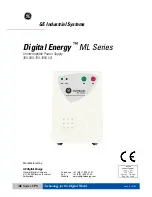
Section I
Theory of Operation
Page 1.2
BP
II S, 3.00
08/96
The inverter then changes dc booster link voltage to precision ac voltage through
pulse width modulation (PWM) inversion. An output filter and Software Harmonic
Conditioner
algorithm provide “clean”, computer grade ac which is then sent to the critical
load. When utility power is available, the rectifier supplies power to the inverter. Should the
utility power fail, the inverter is powered by the batteries for a predetermined length of time.
1.4 Static Bypass Switch
The static bypass switch connects the UPS input to the load in the event of the loss of
the inverter output or an overload condition. During normal conditions, the static bypass
switch is in the open or disconnected mode which isolates the bypass input from the load.
If the inverter output becomes unavailable or exceeds its specified tolerance, the
static bypass switch will close and transfer the load directly to bypass ac power without
interruption. This transfer is automatically inhibited in the event the UPS bypass input is not
within specified tolerance.
As soon as the inverter becomes available, returns to within tolerance or the overload
clears, the static bypass switch will disconnect and transfer the load to the inverter. Note,
however, that so long as the inverter is out of specification, the static bypass switch will
automatically inhibit retransfer of the load.
1.5 Batteries
The 15 batteries contained in the UPS cabinet supply 180 volts dc nominal. They are
the energy reservoir of the UPS and provide dc power to the inverter in case of loss of UPS
input power or rectifier malfunction. The Battery Circuit Breaker electrically isolates the
batteries from the UPS module for maintenance purposes and provides overcurrent
protection at the battery output.
The rectifier/charger normally provides a “float” charge to the batteries. Following
periods of discharge when the batteries have supplied power to the inverter, the
rectifier/charger increases power to the batteries to recharge them. This increased voltage
level is provided until the battery charging current decreases to a preset level. At that point
the rectifier returns to a float charge.
1.6 Control Logic and Control Circuitry
The software upgradable Digital Signal Processor control logic of the UPS provides
the operating and system control for all functions ranging from limiting the inrush current by
“walking” it in, to maintaining the output voltage within rigid specifications, to determining
whether or not the static bypass switch should be activated. The control logic is, for all
practical purposes, the brain of the UPS.








































